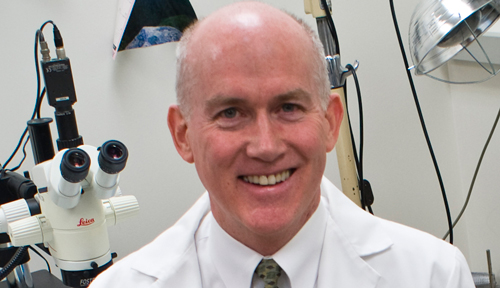When diagnosed with an abdominal aortic aneurysm, all most people can do is worry, watch and wait. Timothy Baxter, M.D., professor of surgery, has compared it to being forced to live with the ticking of a time bomb.
It can take years before an aneurysm is recommended for repair — when it finally grows large enough (about 5.5 cm) that the risk of rupture outweighs the risk of surgery.
“This approach is very unsettling to patients,” Dr. Baxter said.
“Some people, every day they wake up worrying about it,” agreed Jason MacTaggart, M.D., assistant professor, surgery.
Most would rather do something, anything. Now, at least a few of them can.
UNMC is the clinical coordinating center for a $12.2 million multi-center randomized placebo-controlled clinical trial of medical management of aneurysm disease. The management would be via a pill, which some scientists believe will significantly slow aneurysm growth. The study is being conducted under the auspices of a National Institutes of Health grant.
|
|
The Non-Invasive Treatment of Abdominal Aortic Aneurysm Clinical Trial (NTA3CT) aims to enroll 250 patients with the collaboration of 15 top academic medical centers across the U.S.
Fifty percent of the trial’s enrollees will receive the antibiotic doxycycline, an inexpensive generic now widely used for acne and other conditions. Dr. Baxter’s preliminary research in animal models shows the drug inhibits the enzymes which weaken aortic walls, thus causing aneurysms.
If successful, it’s an inexpensive, noninvasive, proactive approach.
Dr. MacTaggart said the surgery to repair aneurysms can come with a mortality rate of up to 3 percent — and a cost that can run from $20,000 to $100,000. More than 40,000 such procedures are done each year nationwide.
“Multiply all of that together,” Dr. MacTaggart said. “If you can change a $100,000 operation to $10 a year for some pills, it’s going to save the health care system a ton of money.”
But the study will show more than whether the pill works. It should also garner a host of invaluable information.
Aortic aneurysms affect 3 percent to 5 percent of the population, but are most common in men age 65 and older, often smokers with a family history.
“It’s considered a silent killer,” Dr. Baxter said, “because there are no symptoms until it ruptures. Most aneurysms we find by luck when imaging is done for other medical conditions.”
And then, there is only worrying and waiting as it grows. Nothing you can do.
Until now.
For more information on potentially enrolling in the study, contact Andrea Anderson, research nurse coordinator.

Who would I contact to be part of this research study?
For more information on potentially enrolling in the study, contact Andrea Anderson, research nurse coordinator, at andrea.anderson@unmc.edu.